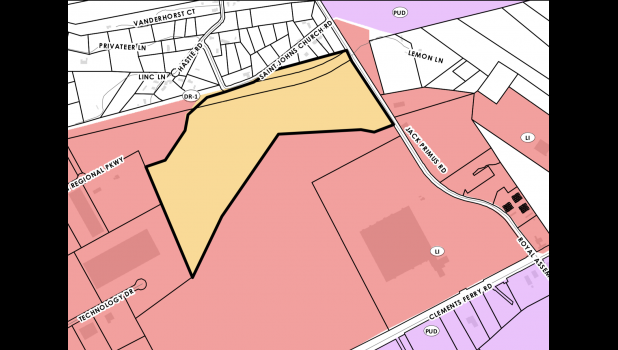Development continues to march on in the Cainhoy peninsula area. At a City of Charleston Planning Commission meeting on June 19, two separate subdivisions were discussed. Both concept plans for the two sections of land were recommended for approval with conditions.
The first subdivision examined for area was what was dubbed the “Mikasa” concept plan, slated for Jack Primus Road, adjacent to Saint Johns Church Road.
According to the Planning Commission’s agenda for the meeting, the project will consist of 161 lots and encompass approximately 78.64 acres. City of Charleston staff recommended approval with the following conditions: the subdivision must be designed in accordance with the requirements of the city’s Stormwater Design Standards Manual (SWDSM), the final street naming network must meet 9-1-1 standards, preliminary and final plats must include the preferred name for the subdivision, and additional curb ramps have to be provided to ensure accessibility to all street crossings.
The list of conditions stated that the Planning Commission believes complying with the SWDSM “will result in a decrease in the number of lots in this subdivision due to limitations on the discharge of stormwater drainage into the wetland system.”
The City of Charleston Traffic and Transportation Department will give additional technical comments at the road construction review for the project.
Todd Richardson, a representative for applicant Synchronicity, said that his company agrees to the conditions.
DI Development Company President Matt Sloan, whose company is managing development of nearby Cainhoy Plantation, was in attendance at the meeting and spoke in support of the project, announcing that they are “excited to see a neighbor there.”
Also on the Planning Commission agenda was “Cainhoy South Hopewell,” a 185 lot and 114.5 acre residential property that will be the first major subdivision within the Cainhoy Plantation development. The concept plan for the new neighborhood was also recommended for approval with conditions. The commission required the applicant, Thomas & Hutton Engineering Company, to also follow the SWDSM, provide qualitative stormwater management for lots along critical areas and jurisdictional wetlands, and potentially add stormwater management buffers. The applicant is expected to update critical line and wetland delineation certifications and include them in all future submittals.
Wetlands are “proposed to be impacted” by the subdivision, according to the commission agenda packet. Jason Crowley of the Coastal Conservation League told the committee at the meeting that his organization wants the project to wait until the Army Corps of Engineers can study the entire Cainhoy area.
“Our primary concern is their Army Corps permit has not yet been approved for the entire 9,000 acres [of the Cainhoy Plantation development],” he said. “This is something that will take decades to build. Therefore, we believe that before the city approves this small subdivision of the overall property, that we should wait until the Army Corps issues its wetland build permit for the overall property.”
This subdivision, which will be located near the intersection of Hopewell Drive and Point Hope Parkway, was given a recommendation for approval.
These two subdivisions are just the latest developments in a rapidly expanding area. Thanks to the continued expansion of Clements Ferry Road, which tracks straight through the Cainhoy Plantation property, more businesses, houses, and apartment complexes are regularly springing up.
Sometimes referred to as Charleston’s final frontier, the Cainhoy peninsula is one of the final undeveloped areas in the city’s jurisdiction. (Credit: Daniel Island News)
For more information on Daniel Island SC and the Cainhoy Peninsula, please contact THE BRENNAMAN GROUP: 843.345.6074 – bob@charlestonproperty.net
